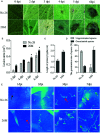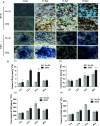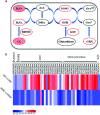Redox Status, JA and ET Signaling Pathway Regulating Responses to Botrytis cinerea Infection Between the Resistant Cucumber Genotype and Its Susceptible Mutant
- PMID: 33101327
- PMCID: PMC7546314
- DOI: 10.3389/fpls.2020.559070
Redox Status, JA and ET Signaling Pathway Regulating Responses to Botrytis cinerea Infection Between the Resistant Cucumber Genotype and Its Susceptible Mutant
Abstract
Botrytis cinerea is an important necrotrophic fungal pathogen with a broad host range and the ability to causing great economic losses in cucumber. However, the resistance mechanism against this pathogen in cucumber was not well understood. In this study, the microscopic observation of the spore growth, redox status measurements and transcriptome analysis were carried out after Botrytis cinerea infection in the resistant genotype No.26 and its susceptible mutant 26M. Results revealed shorter hypha, lower rate of spore germination, less acceleration of H2O2, O2 -, and lower total glutathione content (GSH+GSSG) in No.26 than that in 26M, which were identified by the staining result of DAB and NBT. Transcriptome data showed that after pathogen infection, a total of 3901 and 789 different expression genes (DEGs) were identified in No.26 and 26M respectively. These DEGs were highly enriched in redox regulation pathway, hormone signaling pathway and plant-pathogen interaction pathway. The glutathione S-transferase genes, putative peroxidase gene, and NADPH oxidase were up-regulated in No.26 whereas these genes changed little in 26M after Botrytis cinerea infection. Jasmonic acid and ethylene biosynthesis and signaling pathways were distinctively activated in No.26 comparing with 26M upon infection. Much more plant defense related genes including mitogen-activated protein kinases, calmodulin, calmodulin-like protein, calcium-dependent protein kinase, and WRKY transcription factor were induced in No.26 than 26M after pathogen infection. Finally, a model was established which elucidated the resistance difference between resistant cucumber genotype and susceptible mutant after B. cinerea infection.
Keywords: B. cinerea; cucumber; redox status; resistant; signaling pathway.
Copyright © 2020 Yang, Wang, Chen, Zhou, Xue, Abid and Chen.
Figures








Similar articles
-
Involvement of jasmonic acid, ethylene and salicylic acid signaling pathways behind the systemic resistance induced by Trichoderma longibrachiatum H9 in cucumber.BMC Genomics. 2019 Feb 18;20(1):144. doi: 10.1186/s12864-019-5513-8. BMC Genomics. 2019. PMID: 30777003 Free PMC article.
-
CsWRKY10 mediates defence responses to Botrytis cinerea infection in Cucumis sativus.Plant Sci. 2020 Nov;300:110640. doi: 10.1016/j.plantsci.2020.110640. Epub 2020 Aug 22. Plant Sci. 2020. PMID: 33180717
-
Diversified Regulation of Cytokinin Levels and Signaling During Botrytis cinerea Infection in Arabidopsis.Front Plant Sci. 2021 Feb 10;12:584042. doi: 10.3389/fpls.2021.584042. eCollection 2021. Front Plant Sci. 2021. PMID: 33643340 Free PMC article.
-
Comparative RNA-Seq analysis reveals a critical role for brassinosteroids in rose (Rosa hybrida) petal defense against Botrytis cinerea infection.BMC Genet. 2018 Aug 20;19(1):62. doi: 10.1186/s12863-018-0668-x. BMC Genet. 2018. PMID: 30126371 Free PMC article.
-
Mechanisms and strategies of plant defense against Botrytis cinerea.Crit Rev Biotechnol. 2017 Mar;37(2):262-274. doi: 10.1080/07388551.2016.1271767. Epub 2017 Jan 5. Crit Rev Biotechnol. 2017. PMID: 28056558 Review.
Cited by
-
CsWRKY11 cooperates with CsNPR1 to regulate SA-triggered leaf de-greening and reactive oxygen species burst in cucumber.Mol Hortic. 2024 May 22;4(1):21. doi: 10.1186/s43897-024-00092-5. Mol Hortic. 2024. PMID: 38773570 Free PMC article.
-
Plant immune inducer ZNC promotes rutin accumulation and enhances resistance to Botrytis cinerea in tomato.Stress Biol. 2023 Aug 22;3(1):36. doi: 10.1007/s44154-023-00106-0. Stress Biol. 2023. PMID: 37676331 Free PMC article.
-
Phenotypic Characteristics and Transcriptome of Cucumber Male Flower Development Under Heat Stress.Front Plant Sci. 2021 Oct 22;12:758976. doi: 10.3389/fpls.2021.758976. eCollection 2021. Front Plant Sci. 2021. PMID: 34745192 Free PMC article.
-
Constitutive Defense Mechanisms Have a Major Role in the Resistance of Woodland Strawberry Leaves Against Botrytis cinerea.Front Plant Sci. 2022 Jul 6;13:912667. doi: 10.3389/fpls.2022.912667. eCollection 2022. Front Plant Sci. 2022. PMID: 35874021 Free PMC article.
-
Jasmonic Acid as a Mediator in Plant Response to Necrotrophic Fungi.Cells. 2023 Mar 27;12(7):1027. doi: 10.3390/cells12071027. Cells. 2023. PMID: 37048100 Free PMC article. Review.
References
LinkOut - more resources
Full Text Sources

